
In the years since naval architect Bob Johnson founded Island Packet Yachts, he’s developed quite a following. We’ve had many requests to review his boats, mostly from satisfied owners. The others have come from couples considering the boat for living aboard and cruising. In a period when most boatbuilders are foundering, Island Packet has found a niche and is servicing it admirably.
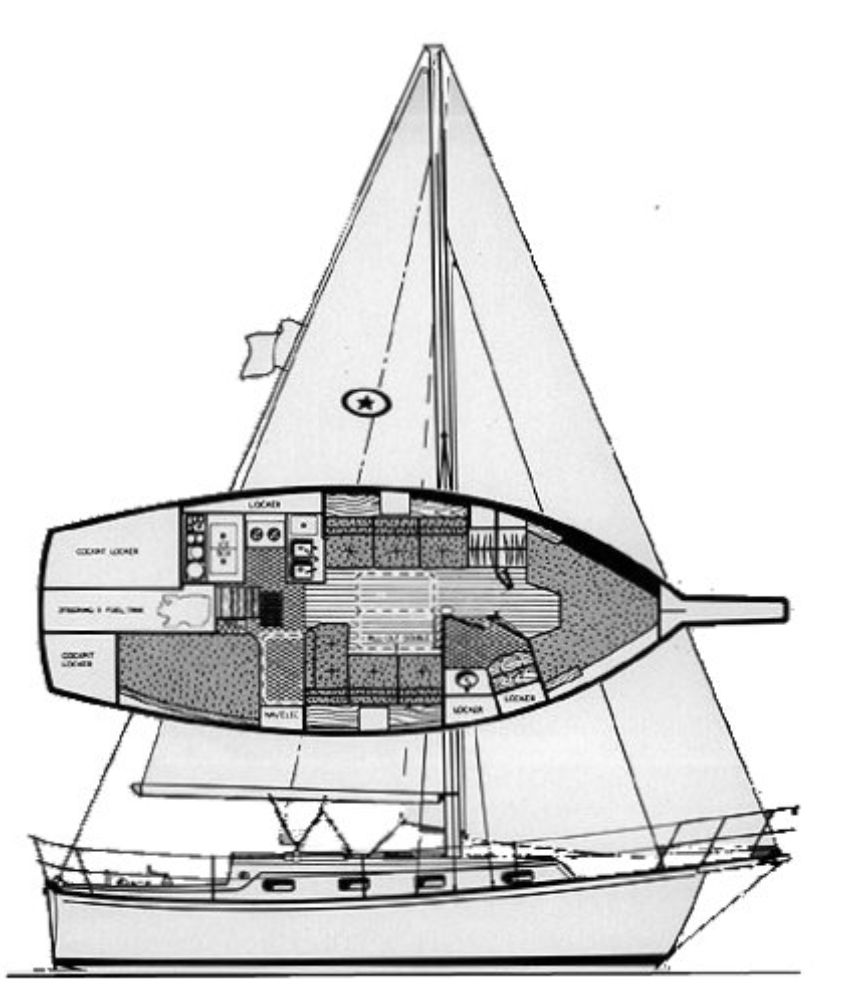
HISTORY
Johnson is a graduate of the Massachusetts Institute of Technology. Before founding Island Packet Yachts he worked as a designer for Endeavour Yachts and Irwin Yachts. In 1979 he launched his own company, Traditional Watercraft, with the 21-foot Lightfoot. A year later he followed with the beamy 26-foot Island Packet (originally called the Bombay Express). Its catboat lines, complete with barn-door rudder, caught everyone’s attention. But it was the completely redesigned Mark II version that really catapulted the company to success.
In 1983, Johnson followed with the Island Packet 31. Orders for 14 were taken at that year’s U.S. Sailboat Show in Annapolis. It remained in production until 1989, after 262 boats had been built. The 31 was replaced with the Island Packet 32. In case you hadn’t noticed, successful builders must at some point introduce new models, even if only a foot shorter or longer, so as not to compete with their own used boats. At present, the company builds a 38-ft. 3-in. and a 47-ft.
THE DESIGN
The entire Island Packet line springs from that first catboat-like 26. You’ll rarely see other boats with the beam of an Island Packet. The overhangs are very short, and the bottom of the early Island Packets is what the company calls “U-shaped.” The bow is almost plumb and the stern is vertical, in line with the trailing edge of the keel-attached rudder. Add a coachroof parallel with the waterline and a cutter rig and you have all the makings of a traditional looking yacht. There is no doubt that this look has found favor with the boatbuying public, and to a large degree it’s responsible for the company’s success.
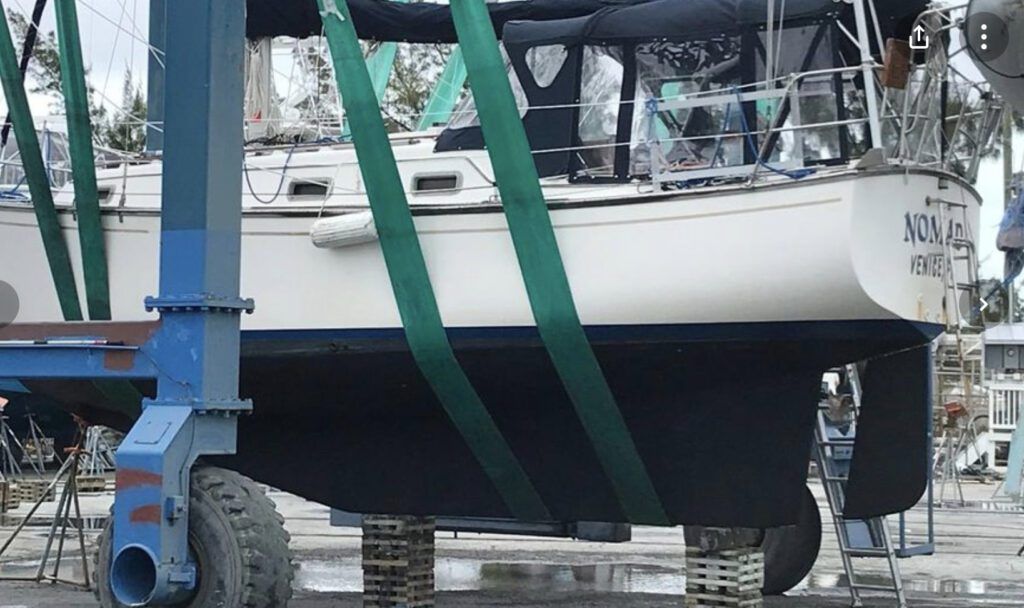
Let’s discuss, for a moment, the wide beam of the 31. At 11′ 6″, it exceeds many other boats of this length. The reasons for it are several. First, a boat derives its stability from two sources—ballast and beam. Both help resist heeling. Johnson obviously started his design with the premise that the boat would be a shoal-draft cruiser. The centerboard version draws just 3′ 0″ board up, and the fixed keel draws just 4′ 0″. With either configuration (about half of those built were centerboards), it isn’t possible to concentrate ballast very low in the boat, especially since iron ingots set in concrete are used (in the deep keel model only) instead of the customary lead, which has a much higher specific gravity.
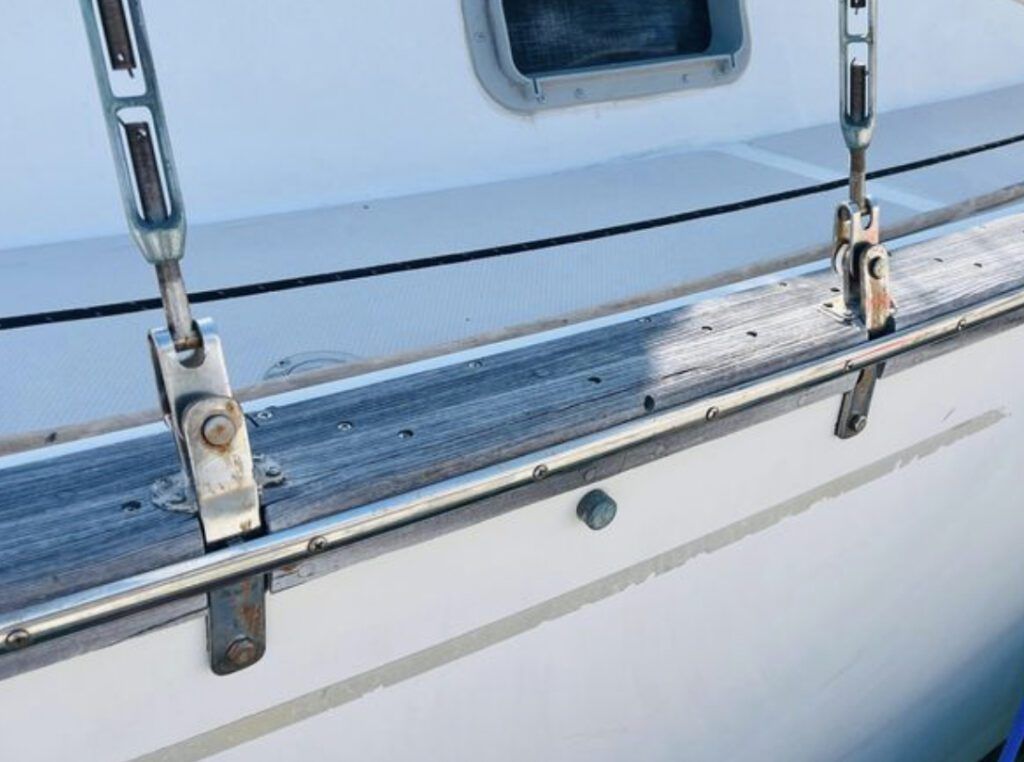
Given the shallow draft, additional stability is achieved by adding to the beam. This brings us to the second reason for the wide beam—greater interior volume, always desirable in a live-aboard.
There is nothing inherently wrong with a shallow draft and a wide beam, assuming you know what you’re trading off. In this case, it’s upwind sailing performance and the increased possibility of achieving inverse stability, that is, a tendency toward tenderness. Beamy, shallow boats have a greater potential to achieve inverse stability than narrow hulls with deep, heavy keels.
On the face of it, this suggests the Island Packet 31 works best as a coastal cruiser, but is less suited to severe offshore work than a narrower hull with a deep, heavy keel. Few remarks seem to vex readers more than the assertion a boat design is best suited to coastal sailing.

We don’t mean to say you can’t take the IP31 offshore. The operative phrase is “best suited.” People have crossed oceans in rowboats, sailboards and mini-boats that were hardly more than bathtubs with decks and spars. Our owner comments include anecdotes of stormy passages that might deter any boat. Sure you can take this boat offshore (the definition of which is yet another semantical quagmire. For the purposes of this argument, let’s say offshore is anywhere away from the coast from which one cannot make harbor at the approach of severe conditions). And probably do so quite happily.
All the talk of capsize screening formulas and righting moment and the like are essentially responses to yachting disasters, such as the famous 1979 Fastnet Race, in which racing boats were damaged by heavy storm conditions, sometimes with the loss of life. Often poor engineering and construction (in the pursuit of light weight) is to blame. In some instances it’s design. Good seamanship probably is more important than either engineering or design.
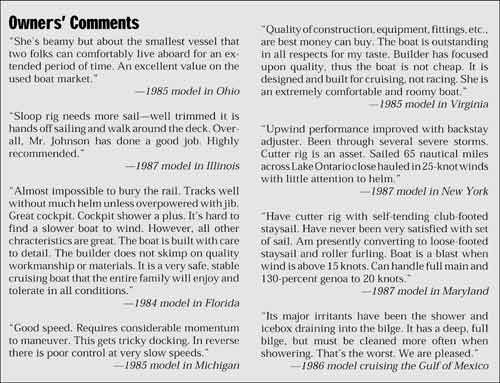
That said, the Island Packet 31 is a handsome, rugged boat that is, according to readers, a delight to sail, well built, and eminently suited to the cruising life.
CONSTRUCTION
The Island Packet 31 hull is solid fiberglass, using triaxial cloth and polyester resin. The deck is “cored” with a mixture of polyester resin and microballoons (called by the company PolyCore) that the company says weighs about the same as a deck with 1/2-inch balsa core. The intent of this innovative method is to avoid using the more common end-grain balsa. This makes for a chemically coupled deck structure without possibility of delamination, common in older boats with balsa cores. No readers have reported problems with their decks. Similarly, we do not have any reported cases of blisters.
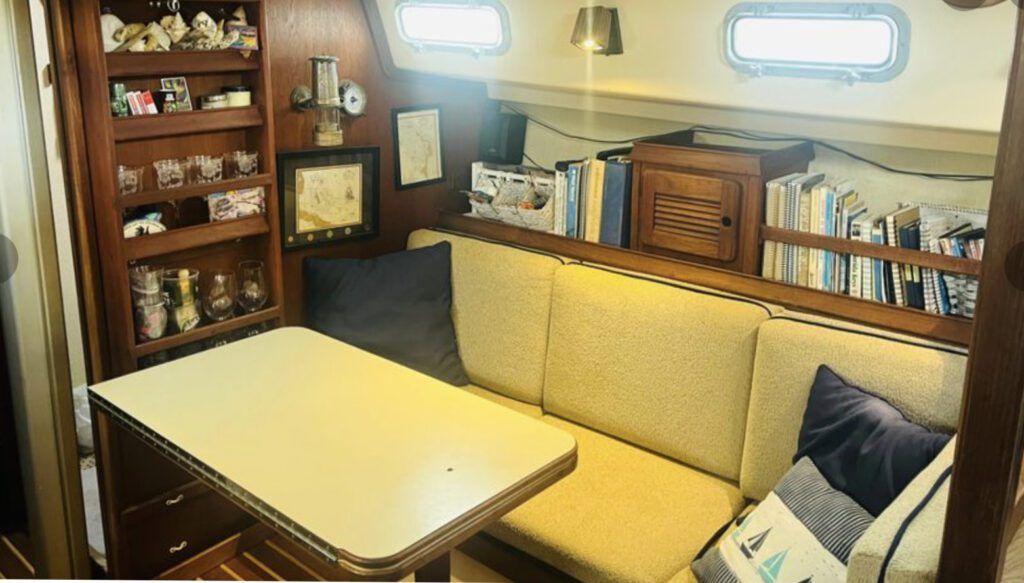
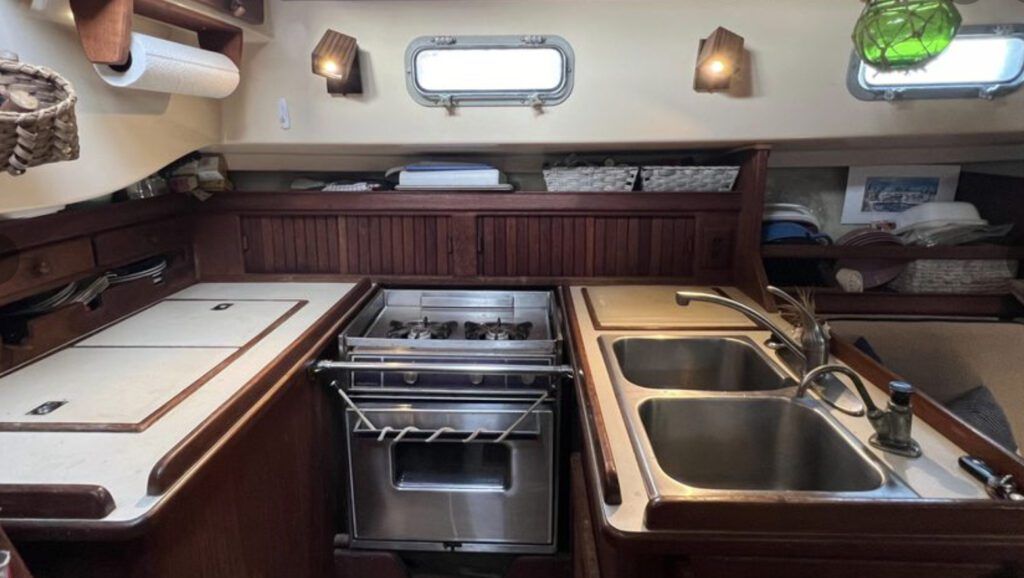
The interior is developed by means of a PolyCore liner tabbed to the hull. We are not fond of such liners, because they do not absorb sound as well as boats with wooden soles and makes any modification of the layout more difficult. If the builder hasn’t carefully planned his tooling, they can obstruct access to some parts of the hull. (Always imagine what might happen if you struck an object in such and such location, and couldn’t you reach the hole to plug it.) However, Island Packet has done a nice job tooling their liners. We like especially the fact that the liner isn’t brought up to window level, but terminates at the backrest of settees so that wood and fabrics hold the eye at mid-heights rather than large, austere panels of fiberglass. The liner also incorporates structural stringers that are bonded to the hull. The sand color of all Island Packet interior and exterior moldings is a trademark, and if you had to commit to one color, this one is easy on the eyes.
The ballast, as mentioned, is encapsulated in the keel cavity. The rudderstock is 1 1/2-inch stainless steel. The semi-balanced rudder has a high-density foam core and is covered with fiberglass. A stainless steel box functions as a “lobster strap.” This connects the keel to the rudder and prevents lines from riding up into the propeller. The centerboard is built essentially the same way, with some lead at the tip.
A 22-hp Yanmar diesel was standard in the early boats, which at least one owner found inadequate. On later versions a 27-hp Yanmar was installed, which provided better power for punching against a tidal current. Island Packet owners cite few problems with their Yanmars.
Hardware is for the most part of good quality—Edson rack and pinion steering, Ronstan blocks, Isomat spars, etc. One owner complained about his Par toilet. Few builders can justify installing expensive models—no one buys a boat for its toilet, despite the fact that malfunctions with the toilet are one of the most onerous repair jobs imaginable. We think the investment in a top quality toilet is repaid many times over.
Readers report overall construction as excellent. Many said that the company pays close attention to detail. Nearly all report good response from the Island Packet staff in resolving problems.
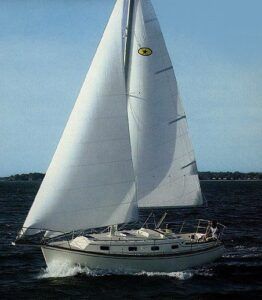
| Market Scan - Island Packet 31 | |
|---|---|
| 1985 Island Packet 31 | United Yacht Sales |
| $52,500 | 772-463-3131 |
| St. Mary's, GA | Yacht World |
| 1986 Island Packet 31 | Turner Marine Yacht Sales |
| $44,500 USD | 310-463-6902 |
| Mobile, AL | Yacht World |
| 1985 Island Packet 31 | Pop |
| $44,350 | 941-841-6814 |
| Venice, FL | Boat Trader |
| 1988 Island Packet 31 | Pop |
| $39,999 | 941-841-6814 |
| Little River SC | Boat Trader |
PERFORMANCE
The Island Packet 31 was offered as a cutter or sloop. Most owners seemed to have chosen the cutter. One reader wrote: “The boat is not a true cutter, but a double-headsail sloop with a 110-percent lapper and a free-set staysail. I recommend either a staysail stay and a hanked-on staysail or disposing of the staysail altogether and sailing her as a proper sloop with roller reefing 150-percent genoa.”
This is technically correct, though the line between cutter and double-headsail sloop is not always clear. On a cutter, the mast is usually stepped near the center of the boat.
On a double-headsail sloop, the mast is stepped farther forward, which is the case with the Island Packet 31. Either way, we’re fervent advocates of a hanked-on staysail on that inner forestay, which is an excellent means of storm management. There are no running backstays, but the company says the Isomat spar was engineered to withstand the loads of the inner forestay without additional support. Owners report being very happy with the cutter rig. Some admit to having to learn the nuances of proper trim of the staysail and genoa. While not necessarily as efficient as a single, large genoa on a sloop, the advantage of two sails occupying essentially the same area is that trimming is easier, and when the wind pipes up, the “jenny” can be furled neatly out of the way.
Not surprisingly, the Island Packet 31’s best point of sail is a reach. Owners say she’s quite fast on this point of sail. Upwind is a different story. One reader said, “Her wide beam forward slows the boat in a seaway.” Another said “she’s slow in light air, fast in heavy air.” Several reported difficulty tacking through the wind, finding it easy to end up in irons. Full-keel boats don’t tack as readily as fin keel boats, but on the Island Packet this tendency seems to be exacerbated by the wide beam forward.
But most report the boat balances well. Readers say she will steer herself for miles with little attention to the helm. One wrote: “Sometimes we thought the autopilot was on and then discovered she was just tracking on her own.” And despite our misgivings about her form stability, owners report she is stiff. “I can’t intentionally wet the rail,” said one reader.
Performance under power is rated as good, as is engine accessibility and reliability.
The only complaint we hear is control in reverse, which is to be expected of a full keel design with the propeller in an aperture. But for a serious cruising boat, that’s exactly where you want the prop—backing down be damned. A little practice will mitigate this annoyance.
INTERIOR
Besides looks and quality, many readers chose the Island Packet for its voluminous interior.
There’s nothing particularly unusual about the layout, which is fine. It works. There are 6′ 6″ V-berths forward, a generous head compartment with shower, settees in the main cabin, a double quarter berth aft to starboard, and a U-shaped galley in the port quarter.
The quarter berth doubles as a nav station, and can be enclosed by a folding door. Headroom in the cabin is 6′ 3″.
“The icebox is huge and exceptionally well insulated (we have Adler-Barbour refrigeration),” wrote one owner. “Used as an icebox it is also great. The interior design is user friendly.”
CONCLUSION
We have reviewed few boats whose owners are more uniformly enthusiastic. This applies to the company as well as the boat itself.
“Ask any owner how they feel about their boat,” wrote one owner. “All Island Packet owners are the sales force of the company. Sit aboard one for an hour, then sail one, and it’s yours.”
| Island Packet 31 | |
|---|---|
| Sailboat Specifications | Courtesy: Sailboatdata.com |
| Hull Type: | Long Keel |
| Rigging Type: | Cutter |
| LOA: | 31.00 ft / 9.45 m |
| LWL: | 27.75 ft / 8.46 m |
| S.A. (reported): | 530.00 ft² / 49.24 m² |
| Beam: | 11.60 ft / 3.54 m |
| Displacement: | 11,000.00 lb / 4,990 kg |
| Ballast: | 4,500.00 lb / 2,041 kg |
| Max Draft: | 4.00 ft / 1.22 m |
| Construction: | FG |
| First Built: | 1983 |
| Last Built: | 1989 |
| # Built: | 262 |
| Builder: | Island Packet Yachts (USA) |
| Designer: | Bob Johnson |
| Auxilliary Power/Tankage | |
| Type: | Diesel |
| HP: | 27 |
| Fuel: | 25 gals / 95 L |
| Water: | 70 gals |
| Calculations and Ratios | |
| S.A. / Displ.: | 17.2 |
| Bal. / Displ.: | 40.91 |
| Disp: / Len: | 229.8 |
| Comfort Ratio: | 22.62 |
| Capsize Screening Formula: | 2.09 |
| S#: | 2.4 |
| Hull Speed: | 7.06 kn |
| Pounds/Inch Immersion: | 1,150.18 pounds/inch |
| Rig and Sail Particulars | |
| I: | 39.50 ft / 12.04 m |
| J: | 14.80 ft / 4.51 m |
| P: | 34.00 ft / 10.36 m |
| E: | 14.00 ft / 4.27 m |
| S.A. Fore: | 292.30 ft² / 27.16 m² |
| S.A. Main: | 238.00 ft² / 22.11 m² |
| S.A. Total (100% Fore + Main Triangles): | 530.30 ft² / 49.27 m² |
| S.A./Displ. (calc.): | 17.21 |
| Est. Forestay Length: | 42.18 ft / 12.86 m |


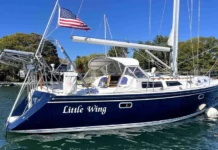
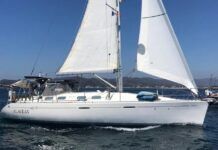
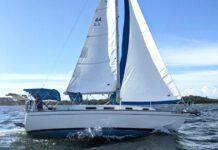






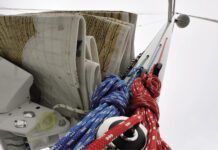

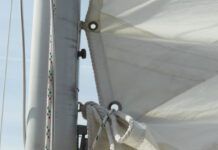




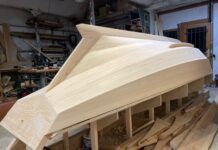
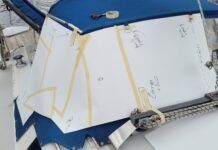


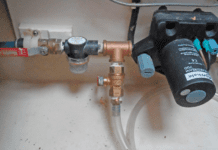




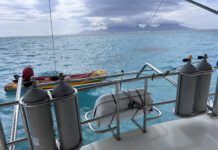











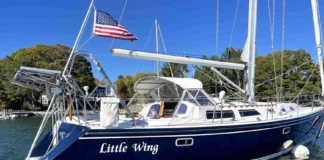
In some past reviews of other boats, compare-and-contrast with similarly sized and/or priced boats had been done. Wish you had done this here. More specifically with a, say, Mason 33.